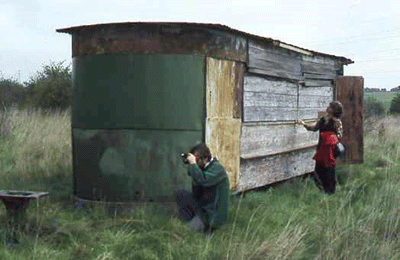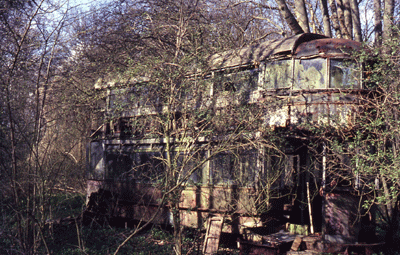A history of Southampton Tramways
1. Introduction
This series of articles is intended to cover the story of Southampton’s tramways from the horse period until the closure of the electric system. There will be a later article giving an overview of subsequent preservation activities at Crich, but mainly concentrating on the local Tram 57 project here in Southampton.
These articles are based on documents and the works of other authors to whom most of the credit for primary research must be attributed. Members of the Tram 57 group have been collecting and researching the history in parallel with the practical restoration work for over 30 years, and it has become evident that this will be a task without end!
The full history of the tramways may never be published – this is not for lack of material, but the economics of producing such a work which will attract a very limited audience condemns it to short potted histories or articles featuring areas of popular interest. Our aim is to ensure all the material is ultimately deposited in the appropriate record library for others to access in the future.
I would like to record special thanks to work done by the late John Price, the late FW (Fred) Cooper, the late H Lourdes-Cresswell and John Horne for which much of these articles are based. Those lucky enough to have a copy of ‘100 Years of Southampton Transport’ published in 1979 to mark the centenary will see that I have mined that extensively for this series.
2. The beginnings
The American entrepreneur George Francis Train is credited with introducing ‘street railways’ to Britain in 1860 where they had been established in the USA since the 1830s. By the early 1870s horse tramways were spreading to many towns and cities across the land and it was in 1872 that the first proposals surfaced in Southampton. The first scheme was subject to opposing from local traders and other influential residents and did not materialise, but by 1876 the town burgers realised they were falling behind other communities and a new proposal gained the approval of the local authority. Work on the first lines started in 1878 and it was passed by the inspecting officer and opened to the public on Saturday 3rd May 1879.
There were only two basic routes – a line starting in Portswood Road where the depot and works were built, that ran along Lodge Road down the Avenue via Above Bar through the Bargate into the High Street and terminating at the Floating Bridge via Oxford Street and Canute Road. The second route started in Shirley High Street, with a depot in Carlisle Road, which traversed Shirley road and Commercial Road to join the other route at Prospect Place (later known as The Junction).
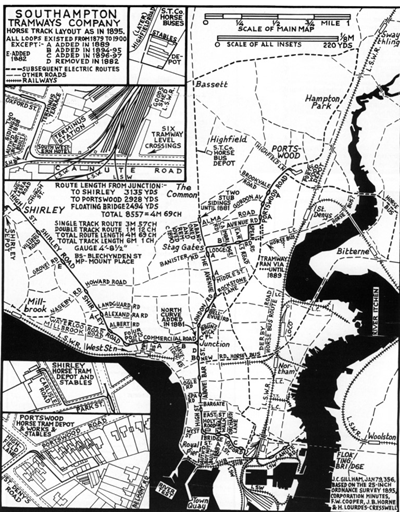
Map 1. Southampton horse tramway system
The system was entirely single track with passing loops, a short branch later left the junction at Lodge road and was carried north up the Avenue terminating by the Cowherds public house. Plans for other extensions to the system came and went, but the company was loath to invest in the system knowing that their lease from the Corporation could be terminated in 1899. Under the terms of the 1870 Tramways Act the lease allowed the Corporation the right to buy out the company after 21 years, or every 7 years thereafter. This was the practice at the time whereby the 1870 Act allowed local authorities to build and own tramways, but not to operate them.
The cars came from a variety of builders. The early cars came from Starbuck of Birkenhead, but latterly most were sourced from the North Metropolitan Tramways Co of Leyton in London.
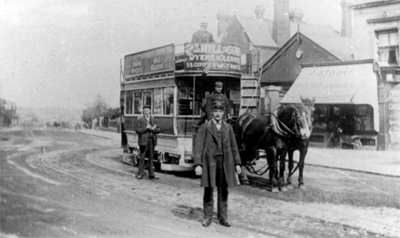
A North Metropolitan tramways built car outside Portswood depot about 1899.
Ultimately, the Corporation exercised its right to buy out the company which took place in June 1898, however, predictably there was a dispute over the estimated value of the company. This dragged on for several months finally gong to arbitration which agreed a price of £51 000 for the undertaking. The next section will look at how the Corporation took over the assets of the company and set about conversion to take electric trams.
3. The Corporation takes over
Despite much of the horse network track having been recently renewed, it all had to be replaced with heavier rail as part of the electrification process. The Corporation had already bought out the local power company and set about installing the underground cables, overhead lines and traction poles on the new system. The first section of track from Shirley to Prospect Place (the Junction) was ready to be opened with due ceremony on January 22nd 1900. By November that year two routes had been opened that largely followed the old horse system less the section on Canute Road. The routes operated from Shirley (short of the later terminus) to the dock station (Terminus Station) and from Portswood depot via Lodge Road to join the other route at what later became known as The Junction.
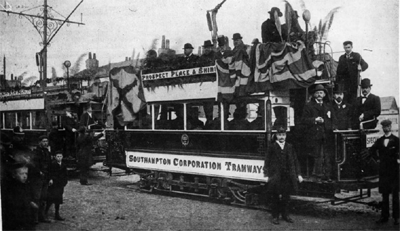
The opening of the Shirley route in January 1900
All the early electric cars were purchased from companied that specialised in tramcar or railway rolling stock construction. The first batch of cars was built by G F Mines & Co of Birkenhead, and were delivered, disassembled, by rail to Southampton and re-assembled in Portswood and Shirley depots. A later batch of cars came from Hurst Nelson & Co of Motherwell in 1903 and these cars later proved troublesome, because Hurst Nelson had little experience of tramcar design as their main business was railway rolling stock. Their design had only 3 side windows with narrow pillars to support the top deck; after only a few years in service they started to fall apart and the tramway department considered scrapping them. However, by this time Portswood had established sufficient engineering capacity to build new cars with bought in trucks and electrical equipment so it was decided to radically rebuild the Hurst Nelsons after which they gave no further trouble.
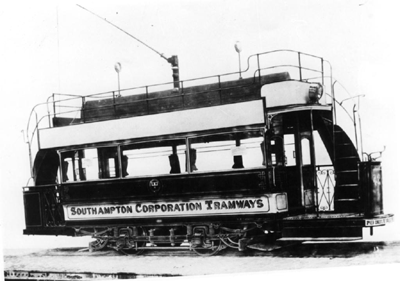
1903 Hurst Nelson car 42 in original condition
The route mileage of the electric system rapidly expanded up to the First World War (see map 2), but the final extension up the Avenue from the Cowherds along Burgess Road to join up with the line at Swaythling only happened in 1930. Further extensions were planned, but not built and reference to the map will show that the tramways hardly penetrated the eastern side of the town with just a short line terminating at the end of Bullar Road. The Itchen river was the main obstruction to this, but it was not helped by the Northam Bridge being a toll bridge and unsuitable for trams, plus there was no fixed crossing further down river, travellers having to rely on the Corporation owned Floating Bridge.
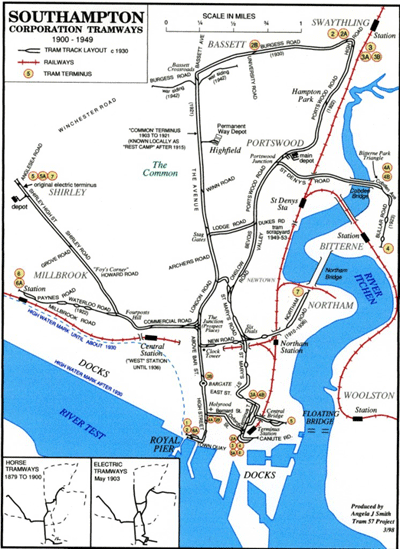
Map 2 The electric system at full extent
In the next part I will look at developments up to the 1930s including the construction of cars at Portswood and how the ‘Bargate’ problem was finally solved.
From WW1 to the 1930s
4. World War 1 and after
During the First World War the tramway system came under great pressures – increased patronage due to war industries and the military port operations adding to the loss of many male members of staff who joined up. Portswood tramway works were in the midst of rebuilding the flawed Hurst Nelson cars which in some cases resulted in an almost new body so, with the loss of manpower and material shortages, there was little chance of building new cars. Some relief was gained by acquiring some second hand ex-LCC cars which arrived in 1918. These were standard 4 wheel cars with open platforms, but totally enclosed top decks, and the cars arrived and were put into service without modification on the St Marys Street route in August.
After the war they were taken into the works and the top deck covers were removed and the lower saloon height dropped by 7 inches to allow them to run anywhere on the system including the Bargate routes. Car nos 75-80.
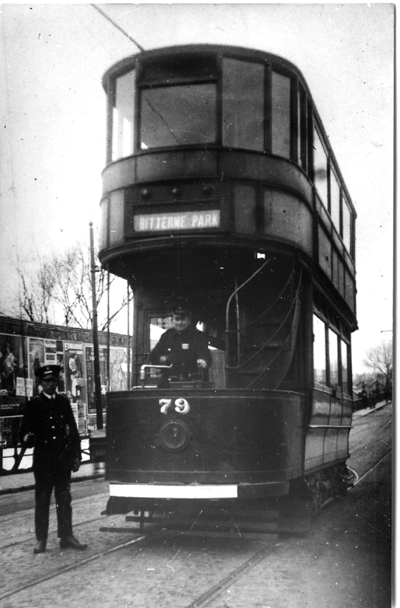
ex LCC 79 in near original condition c1918
Ladies served with distinction as clippies and were trained as drivers in some towns and cities.
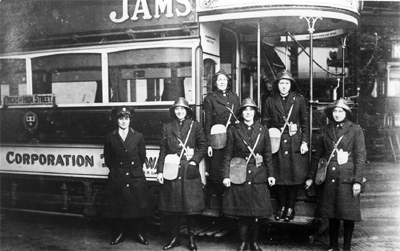
lady conductresses during World War 1
After the end of the war the Corporation ordered a batch of ten standard enclosed double deck cars from United Electric Car Co of Preston (later to become know as English Electric) and these bore the numbers 82 to 91. They were always restricted to routes that did not pass through the Bargate.
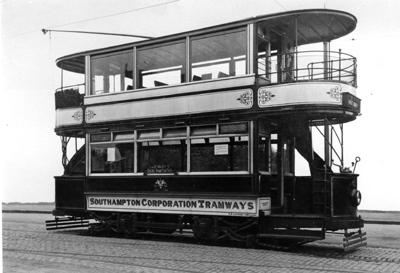
UEC car 83 in original
One further odd car worth a mention is number 81 built by SCT at Portswood in March 1919, it was unique in having five windows in both saloons. The car was longer overall than other Southampton trams and speculation is that it was intended to test the use of bogie running gear in the town, but this never happened. 81 was originally constructed with a flat roof fully enclosed top cover, but this was later converted to the standard TCB pattern in 1929 which allowed the car to be used on Bargate routes.
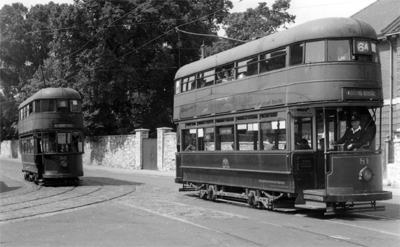
A post war view of car 81 in
5. The ‘Bargate’ problem
By the 1920s the Bargate was beginning to prove an obstacle to the free movement of traffic between the High Street and Above Bar, particularly with the rise in the number of motor vehicles, and this issue began to be a regular item on the council debating sheet.
However, in lieu of any long term solution, the tramways department was equally anxious to provide a more consistent fleet of top covered cars to satisfy the travelling public. James Dobson designed a new type of car which, although still open top, was a distinct improvement on earlier models. The first car, numbered 2, had a fully enclosed lower saloon and platform with transverse garden seats on the upper deck.
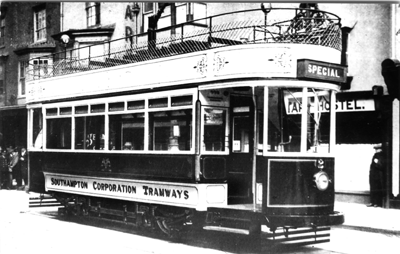
Car 2 as originally built at Portswood in 1920
Only 5 cars of this design had been built when Percy Baker was appointed as acting Tramway Manager and Engineer in 1923. He took the Dobson design and re-worked it to incorporate a dome shaped top cover, together with a low height truck, small wheels and high speed motors. The prototype car 12 was rolled out for inspection later that year and his confirmed appointment as permanent tramways manager was assured when the car proved a great success. Over 50 more cars to a similar design – both new, and converted from suitable open top cars - made these typify Southampton Tramways until closure.
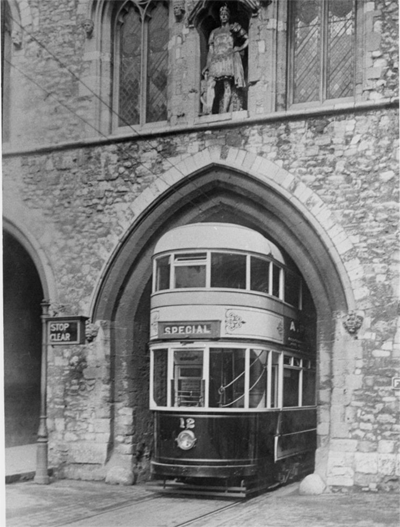
prototype car 12 posing for the press in 1923
The earlier open top Dobson cars were subsequently modified by adding the dome roof and lowering the lower saloon by 4 inches. Now all the dome roof cars and original open toppers could go anywhere on the system and the only restricted cars were the ten UEC vehicle numbered 82 to 91.
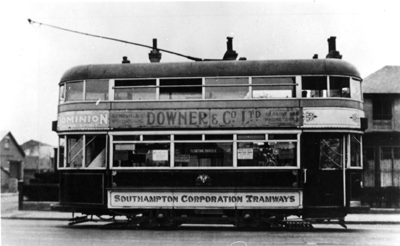
Milnes car 31 rebuilt with dome roof
6. The Bargate problem finally solved
Despite the new design of top covered car able to negotiate the medieval arch, the Bargate was still a traffic bottle neck. The council started buying up the properties either side of the archway in the 1930s until they could demolish enough buildings on the eastern side to create a bypass in 1932.
The western bypass was finally opened in June 1938 when car 8 became the last tram to negotiate the arch, passing through on 4th June in that year.
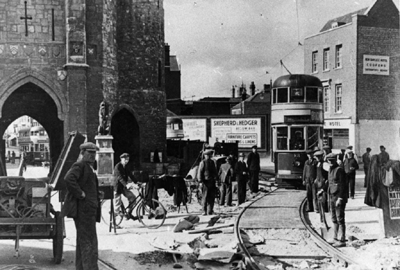
The first tram round the Bargate western by-pass 5th June 1938
The success of the Top Covered Bargate (TCB) tram in 1923 led to efforts to modernise the design as time went by. An improved version was introduced in the early 1930s and was nicknamed the ‘Pullman’ car due to its plush interior. Other changes were flush metal body sides that allowed 2 plus 2 seating in the lower saloon for the first time and upholstered seats on both decks. The last new ‘pullman’ cars were built at Portswood between 1929 and 1931.
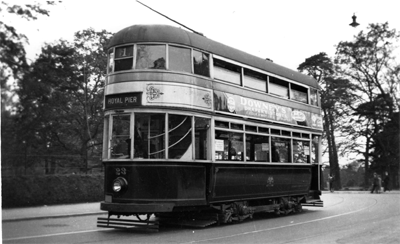
Pullman car 23 in as new condition about to enter the Avenue from
8. Looking to the future
In common with many provincial towns and cities in the 1930s Southampton council was considering the future of the tramway system. Years of using the profits from the transport department to offset the rates meant that there was no sinking fund to cover the cost of major infrastructure renewal and, after over 30 years of use, the track was worn out. The transport industry of the day was looking towards the trolley bus as the way forward. Already on the South coast Bournemouth, Portsmouth and Brighton had made the decision to go down this route. It neatly allowed the continued use of cheap local power supplies, but without the need for costly and disruptive track renewals. Trolley bus design had benefited from the improvements in motor bus technology incorporating light alloy bodywork, comfortable seats and pneumatic tyres.
However, the gathering clouds of war changed this plan as we shall see in the next instalment.
The late 1930s through to closure
9. Deciding the future
By the mid 1930s the future of the tramway system was under review by the Council as it was clear that the state of the track was giving cause for concern. Much of the system needed significant investment in track renewals and other parts of the infrastructure to repair wear or update to modern standards and this would have to come out of the council coffers as there was no sinking fund to cover this. Thoughts turned to alternative options and the most favoured was conversion to trolleybus as had been done in Portsmouth, Bournemouth and Brighton during this period. And so the decision was made to abandon the system by 1940 and convert to trolleybus.
The first route affected was to Millbrook station which was closed to normal traffic in October 1935, although the line remained in use for workmen’s services. The following year the short route from Clock Tower to Northam was closed completely in June – this line had never realised its potential due to the obstruction of the toll bridge at Northam which prevented trams reaching Bitterne.
However, before any more closures could take place events were overtaken by the outbreak of World War 2.
10. World War II
With fuel rationing soon in place many bus services were cut back or curtailed and the trams had to take on increasing traffic and the Millbrook route was soon re-opened for all users.
As we all know, Southampton was hit hard by the Blitz, but the tramway managed to escape major damage and only one car was completely destroyed (No 31) and another lost its roof in Shirley Road (car 13).
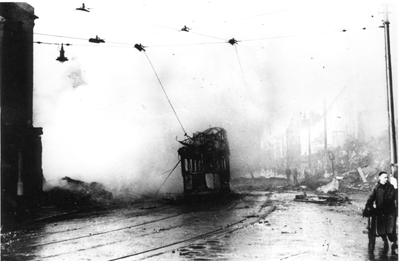
However, the Tramways department was aware of the risk that a bombing raid could destroy Portswood or Shirley depots which would effectively wipe out half the fleet. So work was undertaken to lay two temporary sidings alongside the Avenue just below Burgess Road and these were used to park a number of older cars overnight to mitigate such an occurrence. (Bristol lost its tramways due to heavy raids and never re-opened).
11. Post war interlude
After the war ended, conditions had changed and the pre-war decisions were looked at again and it was decided to opt for conversion to motor bus. Factors that influenced this decision were based on the rapid development of reliable and economic diesel engines (such as the Gardner series) and the nationalisation of the electricity generating industry which spelt the end of cheap local power for electric vehicles. Ironically this gave the tramway a stay of execution for almost four and a half years as it would take until 1949 – 50 for the bus industry to recover from war time service and make up back orders.
The Corporation Transport Department looked at a number of manufacturers before deciding to buy a fleet of Guy Arab buses that were to serve the town well for many years.
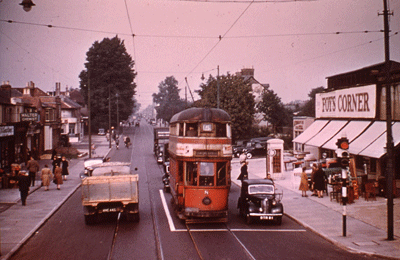 |
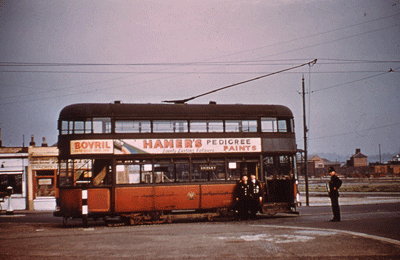 |
| Car 8 waits for the traffic lights to change at Foys Corner in 1949 | The crew of Pullman car 21 pose for the camera at Floating Bridge terminus in 1949 |
12. Enthusiast tours
There was a growing interest in tramways by enthusiasts with the formation before the war of the Light Rail Transport League (LRTL), which was a pressure group to promote the retention and modernisation of tramways before the war. Within this group many enthusiasts arranged visits to photograph and ride on systems threatened with closure and these even continued to some extent during the war. By 1945 Southampton was the last tramway system operating along the south coast and also the last in the country to regularly still use open top cars in every day service. As such it became a favourite destination for many tour groups, notably the LRTL and Southern Counties Touring Society.
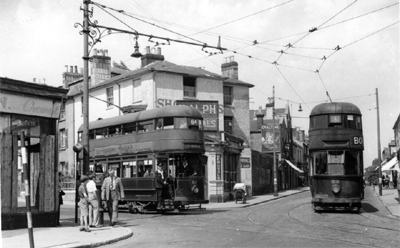
Car 81 (on left) in Bellevue Terrace on an enthusiast tour in 1947
On one such tour in 1948 some members, knowing of the imminent demise of the system, suggested an attempt should be made to preserve one of the open top cars for posterity. Later an approach to the Transport department resulted in an offer of car 45 repainted and overhauled for the princely sum of £10! Thus a Southampton tram became the very first to be preserved by amateurs in this country and went on to become the basis for the founding of the National Tramway Museum, now located at Crich in Derbyshire.
13. The last rites
Route closures began in earnest in 1948 when the delivery of replacement buses at last began in useful numbers. The last route to remain in operation was Shirley to Floating Bridge, although the line to Portswood remained operational for car movements . On the very last day, December 31st 1949, car 9 was decorated with flags and lights as the special ‘last car’. When normal service ended that evening, car 9 started from Floating Bridge at 10.57pm with special guests and made its final journey to Shirley depot arriving amidst great crowds just before midnight. And that was the end – car 9 was stripped of any portable components as New Years celebrations got under way.
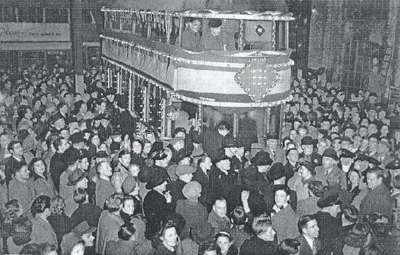
Car 9 negotiates the Junction on the last day of service, December 31st 1949
This was not quite the last tram movement – depot transfers continued between Shirley and Portswood until February when the overhead was taken down and the track started to be taken up by workmen.
14. Disposals
Most of the redundant older cars ended up in Harris’s scrapyard in Bevois Valley where metal parts were recycled and the wooden bodies were burnt, but it was well into the mid 1950s before all the bodies had gone. Other cars were resold to Southern Engineering at the bottom of Shirley and ended up as workshops, chicken houses and holiday homes. The Corporation sold many of the newer dome roof cars to Leeds where a few saw further service for up to 3 years, but I hope to cover this and the preservation era in more detail in the final instalment.
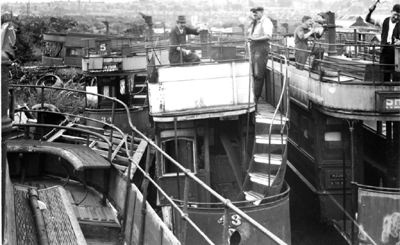
Open top cars are broken up in Harris’s scrapyard in
Some early hand coloured postcard views
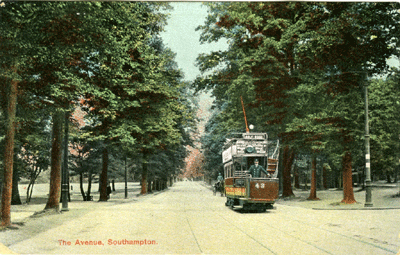
An early view of car 43 in original condition opposite the Cowherds public house about 1905
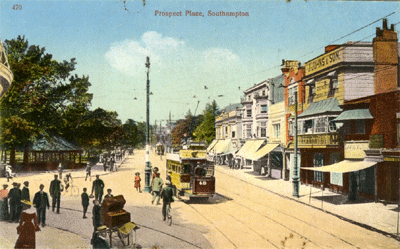
Prospect Place (now known as ‘The Junction’) circa 1905, looking towards
Post closure and preservation
15. The trams that went to Leeds
A number of the later ‘Pullman’ TCB cars were sold to Leeds who were short of cars after the war. These were soon followed by many more of the older style TCBs which were immediately diverted to a scrap yard on the outskirts of the city as they were deemed entirely unsuitable by the Leeds transport department. Apparently, the Leeds council deputation to inspect and approved cars for purchase from Southampton did not include a transport engineer and thus it is implied that Southampton took advantage of this to dispose of life expired cars at a good price, when they were only fit for scrap.
A small number of the former ‘Pullman’ cars entered service in Leeds, but none lasted more than 3 years before withdrawal. When the London system closed in July 1952 it unlocked the supply of many superior Feltham class cars which went north to Leeds and allowed the other second hand cars to be scrapped. The ex-Southampton cars were unpopular with the Leeds travelling public and the transport department due to the lack of upper deck headroom and air brakes.
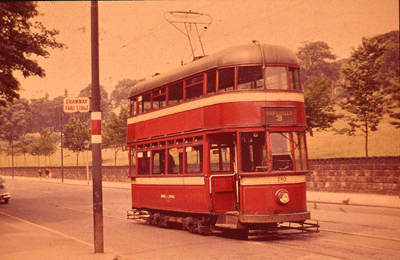
Leeds 290 ex Southampton 108
16. Car 45 and the founding of the Tramway Museum Society
An enthusiast tour of the remaining Southampton system by the LRTL in August 1948, led to a proposal to preserve a complete open top car. By this time Southampton was about the last place in the UK still using open top cars in every day service, however, before this time no amateur group had preserved a tramcar. After an approach to the transport department the group was offered car 45 for £10.00 including the cost of a repaint and minor truck overhaul! Car 45 led a very peripatetic life staying at Leeds, Blackpool and eventually the Motor Museum at Beaulieu, until the newly formed Tramway Museum Society found a permanent home for their growing collection at Crich in Derbyshire. So it is fair to say that preserving a Southampton tram was responsible for the founding of the subsequent (enthusiast driven) tramway preservation movement.
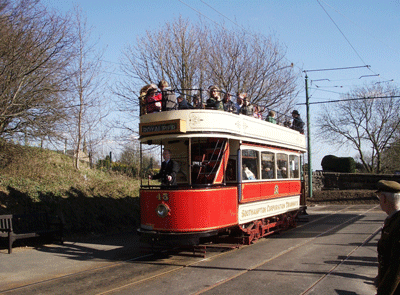
Southampton car 45 at the Tramway Museum in Crich, Derbyshire
Southampton Tram Project
In the early 1970s the Southampton City Museums thought it would be a good idea if they could find a tram to put on display to show local people how their forefathers went to work and play. An approach to the Southampton University Industrial Archaeology Group resulted in the discovery, in 1973, of a tram body in a garden on the outskirts of Romsey about 8 miles from the city. This turned out to be Car No 57 built locally in the Portswood tramcar workshops in 1910 as an open top ‘knifeboard’ seat tram designed to pass under the medieval Bargate arch. A unit from the local Royal Corps of Transport at Marchwood recovered the body in 1975 as an exercise and it went into a garage in a council yard not far from its original birthplace in Portswood.
The original plan had been to use local authority funding to restore the car for display but, unfortunately, this finance was soon looking very remote. Another approach to the IA group resulted in the formation of the voluntary Tram 57 Project to try and kick start some restoration work. We tidied up the car and held an open day in 1977: about 200 people visited to see a rather sorry looking 57, but a couple of visitors told of other tram bodies in the local area.
We followed up a number of leads and came across the astonishing discovery of a complete top covered ‘Bargate’ car, fleet number 11, on a private estate near Alresford in the east of Hampshire. Another tip-off led us to the body of Car 38 in a field near Fordingbridge on the western edge of the county.
|
|
|
|
Car 38 as found in 1979 near Fordingbridge |
Car 11 as found in 1977 |
Both of these finds showed potential for restoration to running condition (unlike 57) and we made arrangements to have them transported into a more suitable workshop on a British Gas site at Millbrook, Southampton. Both bodies moved in towards the end of 1979 and the group set about the task of survey to determine a practical restoration programme. In 1985 the body of Car 57 was moved to more suitable storage at Town Depot near Itchen Bridge, although no work was ever done there.
Our ultimate goal?
The Southampton Tram Project exists solely to support the restoration of the 3 trams for eventual display in the city of Southampton (or at least in Hampshire). Ownership of Cars 11 and 38 has been transferred from the city to Solent Sky aviation museum which is fully accredited under the MLA and acts as an umbrella body to whom we report.
Over the years we have worked with Southampton City Council to promote a number of schemes that would have had the potential to provide a display base and possible short operating line for the two cars that could run. So far nothing concrete has been developed, either for reasons of location or cost or both. Southampton has a rich transport history from the last two centuries including aviation, shipping, railways, buses and trams.
Unfortunately we had to quit the Millbrook site in 2003, where we had been based for 24 years. The trams and components were stored in various buildings around the city and, sadly we were not able to work or receive visitors.
We currently have a workshop located in the Eastern Docks adjacent to the Ocean Cruise Terminal which has been our home for the last eight years. However, we will have to move from there in mid-2019 to make way for expansion of the facilities in and around the terminal to accommodate the next generation of mega cruise liners. We are looking for a new site where we can establish a permanent base with the security of tenure to allow us to apply for grant-funding support and thus bring the restoration of Car 11 to a successful conclusion.
How far have we got?
Well, in Crich terms, we may not seem to have achieved much in 30+ years when the Tramway Museum Society workshop could turn out a major restoration in under five! But then we only have about 4 or 5 regular volunteers and we sometimes only manage a work session once a month in winter! So, in effect, we have few volunteers, almost no money and no clear completion date to aim for, but we keep going on sheer enthusiasm.
We long ago made the decision to concentrate our limited resources on the unique dome roof Car 11, so little work has been done to Car 38 apart from a new underframe and floor, and some cosmetic work on the interior varnish.
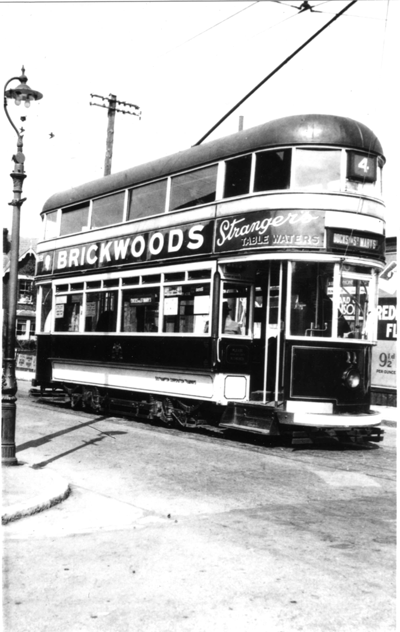
Illustration shows car 11 at Bullar Road terminus 14th May 1932.
G N Southerden, TMS collection
Car 11 is technically known as a TCB car – this stands for Top Covered Bargate, indicating that it was able to pass under the ancient Bargate arch that straddles Southampton’s main street. In fact the car, built at Portswood, went into service in April 1923 as an open top vehicle with garden seats on the upper deck. After the success of Percival Baker’s new design of top cover to fit under the Bargate later the same year, 11 and her four sisters were quickly given top covers to the same design.
Car 11 is about 80% to 90% complete and we have all the major components including a rebuilt small-wheel truck and motors. We are at the fitting-out stage, with platform controls, sanding gear, lifeguards and some windows still to be completed.
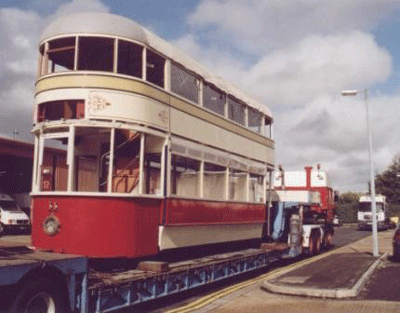
Car 11 being moved into store September 2003
Car 38 was built by Hurst Nelson in 1903 in the same batch as car 45 – thus these trams celebrated their centenary in 2003. Our aim is to eventually rebuild 38 to its intermediate condition circa 1913 with 4 windows, but still retaining the flat dash and uncanopied, in which form it should complement rather than duplicate 45. We have an ex-Porto truck for Car 38 and controllers, and although much of the upper deck will need to be reconstructed, amazingly the trolley base survived.
What about car 57?
The one vehicle not in Southampton is Car 57, which is in store at the County Museums premises at Chilcomb, near Winchester. 57 was in too poor a condition to ever restore to running order, but the plan was to perhaps use it to show how a tram is constructed by having some cut-away sections and maybe with one end in ‘as found’ condition with the other fully (cosmetically) restored. Unfortunately, due to cuts in local authority funding, this prospect seems very far away.
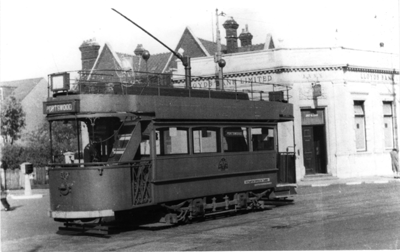
Car 57 at Portswood Junction during WW2.
Photo W J Haynes
The other car in our collection is Lisbon 715, bought as a source as spares, but paradoxically, it is almost in running condition!
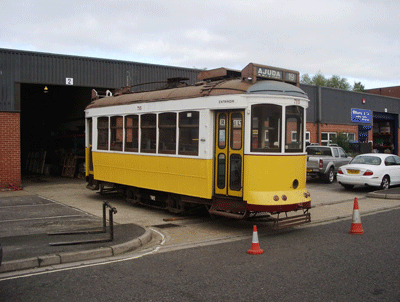
Lisbon 715 outside a council store
After note:
In 2012 we re-branded ourselves as the Southampton Tram Project to reflect the fact that car 57 is no longer in our collection.
Southampton Tram Project - for more information about the project please E-mail or visit their Facebook Page.
(All photos Southampton Tram Project unless otherwise credited)


